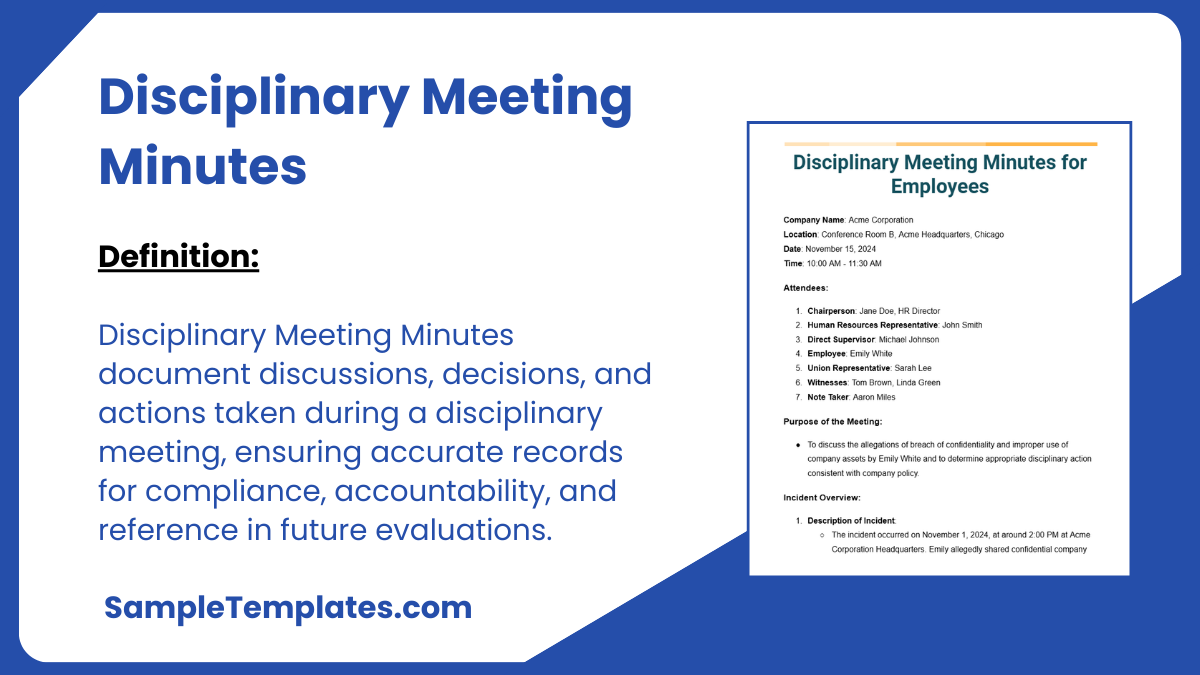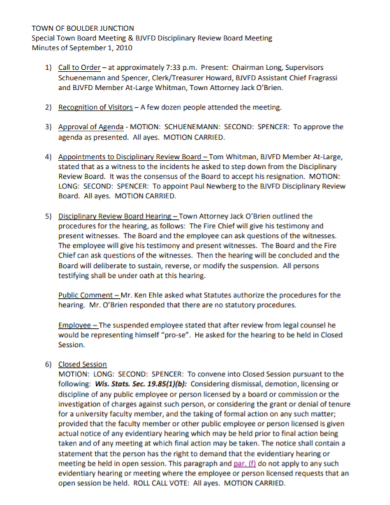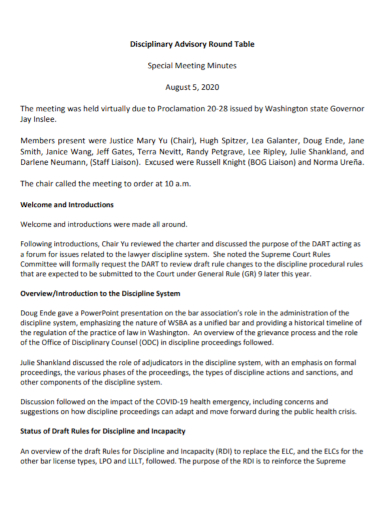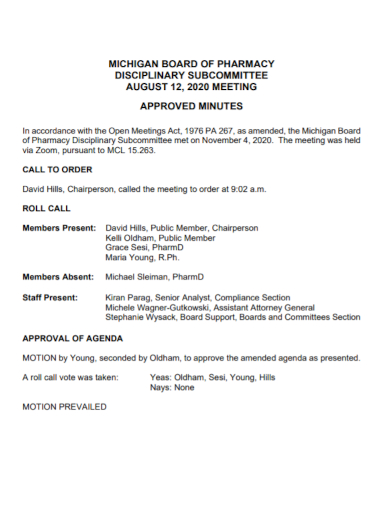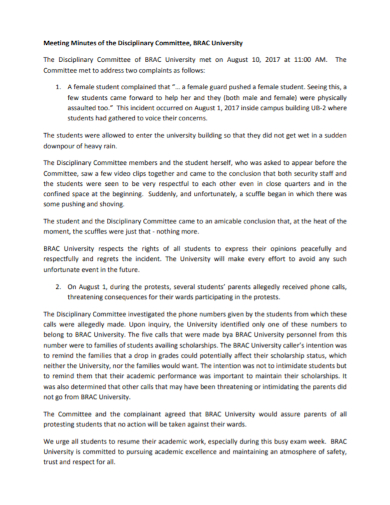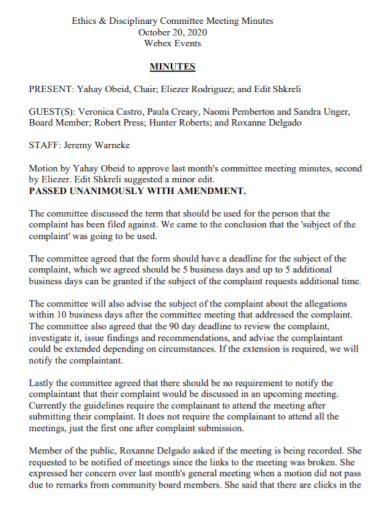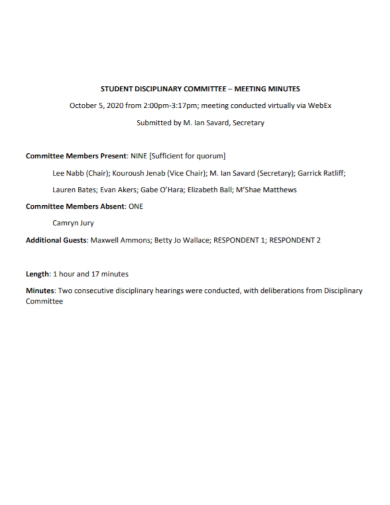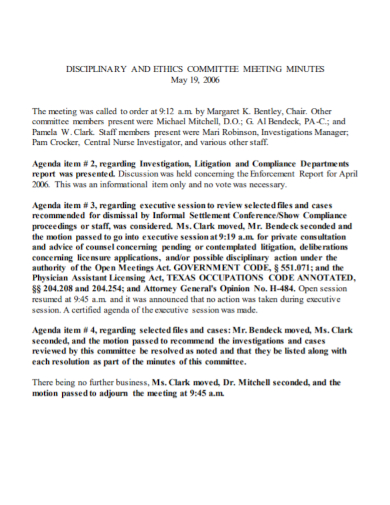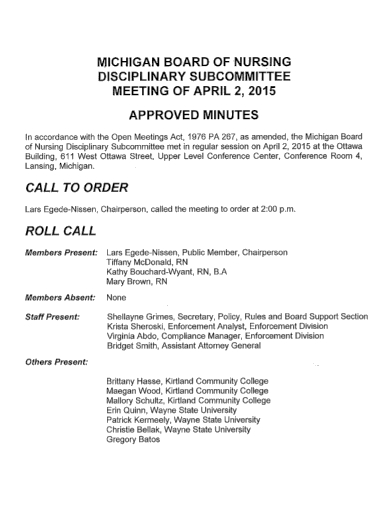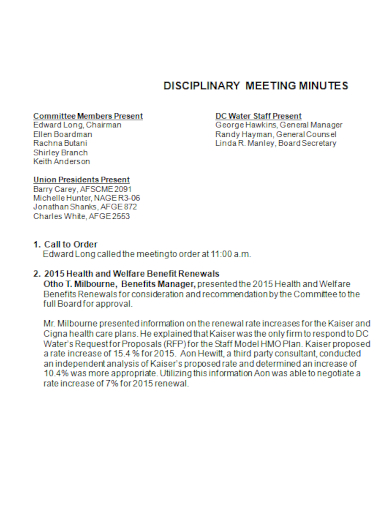A disciplinary meeting is a significant step in the disciplinary process. To maintain justice on both sides and avoid any potential unfair dismissal accusations, it’s critical that you constantly follow proper procedure. The goal of disciplinary hearings is to provide accused employees a chance to present evidence in defense of the allegation and to contest their accusers’ assertions before an adverse decision is made. In a disciplinary hearing, taking note of how the whole meeting went is of the essence. Keep reading this article to check our free and ready-to-use samples of Disciplinary Meeting Minutes in PDF and DOC formats that you could use for future purposes.
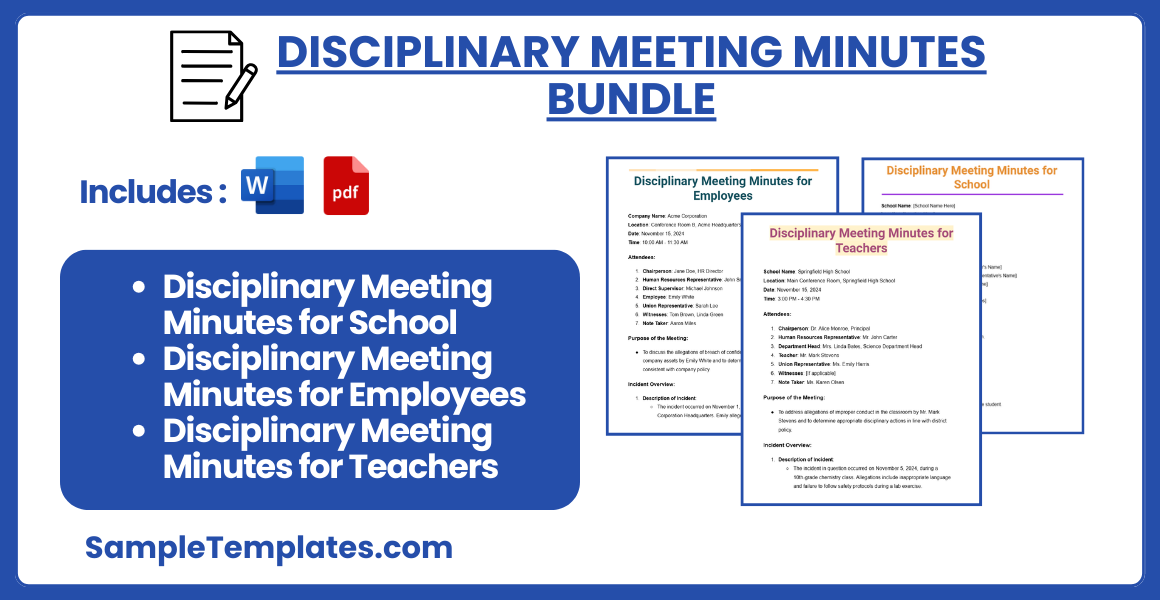
Download Disciplinary Meeting Minutes Bundle
Disciplinary Meeting Minutes for School
School Name: [School Name Here]
Location: [Location Here]
Date: [Date of Meeting]
Time: [Start Time] – [End Time]
Attendees:
- Chairperson: [Chairperson’s Name]
- Faculty Representative: [Faculty Member’s Name]
- Student Affairs Representative: [Representative’s Name]
- Parent/Guardian: [Parent/Guardian’s Name]
- Student: [Student’s Name]
- Other Attendees: [List any other attendees]
Agenda:
- Introduction
- Brief introduction by the chairperson.
- Purpose of the meeting.
- Incident Overview
- Description of the incident.
- Presentation of evidence.
- Statements from witnesses (if any).
- Student’s Statement
- Student’s account of the incident.
- Questions from the committee to the student.
- Discussion
- Discussion of the incident details.
- Review of relevant school policies and past precedents.
- Parent/Guardian Input
- Comments and observations from the parent or guardian.
- Questions directed towards the parent/guardian.
- Deliberation (Closed session if necessary)
- Committee deliberates on the evidence and statements presented.
- Consideration of appropriate disciplinary actions.
- Decision
- Summary of findings.
- Disciplinary actions to be taken.
- Any recommendations for follow-up or preventive measures.
- Closing
- Next steps and follow-up actions.
- Closing remarks by the chairperson.
Actions to be Taken:
- [List any actions decided upon, who is responsible, and any deadlines.]
Additional Notes:
- [Any additional information or notes that were discussed during the meeting.]
Adjournment:
- Time Meeting Ended: [Time].

Disciplinary Meeting Minutes for Employees
Company Name: Acme Corporation
Location: Conference Room B, Acme Headquarters, Chicago
Date: November 15, 2024
Time: 10:00 AM – 11:30 AM
Attendees:
- Chairperson: Jane Doe, HR Director
- Human Resources Representative: John Smith
- Direct Supervisor: Michael Johnson
- Employee: Emily White
- Union Representative: Sarah Lee
- Witnesses: Tom Brown, Linda Green
- Note Taker: Aaron Miles
Purpose of the Meeting:
- To discuss the allegations of breach of confidentiality and improper use of company assets by Emily White and to determine appropriate disciplinary action consistent with company policy.
Incident Overview:
- Description of Incident:
- The incident occurred on November 1, 2024, at around 2:00 PM at Acme Corporation Headquarters. Emily allegedly shared confidential company information with an external party via email and made unauthorized use of company equipment for personal projects.
- Violation of the company’s confidentiality agreement and misuse of company property policy.
- Evidence Presented:
- Copies of email exchanges between Emily and the external party.
- Security logs showing unauthorized access to the equipment after hours.
- Witness statements from Tom Brown and Linda Green corroborating the unauthorized access.
Employee’s Response:
- Emily acknowledged the email exchange but claimed it was a misunderstanding about what constitutes confidential information. She apologized for the misuse of equipment, stating it was done during a lunch break and did not harm the company.
Discussion:
- Discussion on the severity of the breach and its potential impacts on the company.
- Michael Johnson noted Emily’s previously clean record and strong performance reviews.
- John Smith emphasized the importance of adhering to company policies but suggested considering a balanced approach given her history.
Decision:
- Outcome:
- Issuance of a written warning to Emily White.
- Emily is required to attend a refresher training on company policies and data security.
- Follow-Up Actions:
- Schedule for policy training set for December 1, 2024.
- A follow-up meeting in three months to review Emily’s conduct and compliance with company policies.
- HR to provide counseling services if Emily requests.
Closing:
- Summary of disciplinary actions and reminders about the confidentiality of the meeting.
- Confirmation that Emily has the right to appeal the decision through the company’s standard appeals process.
Meeting Adjournment:
- Time of Adjournment: 11:30 AM
- Date for Next Meeting: February 15, 2025, for follow-up review.
Approval:
- Minutes approved by: Jane Doe
- Date of approval: November 16, 2024
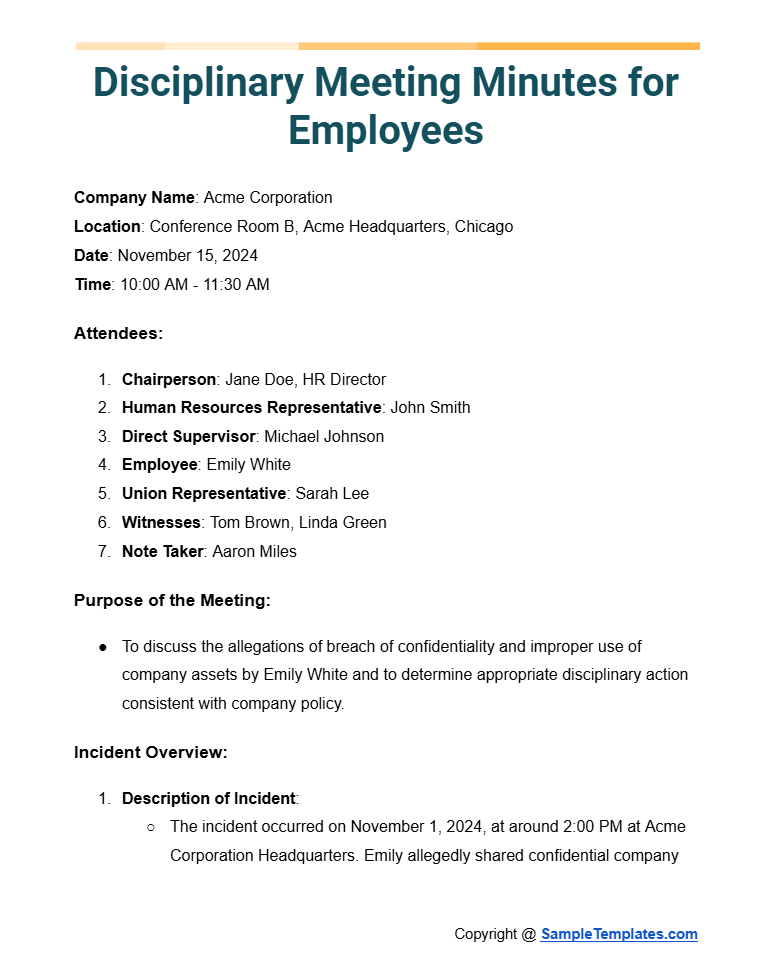
Disciplinary Meeting Minutes for Teachers
School Name: Springfield High School
Location: Main Conference Room, Springfield High School
Date: November 15, 2024
Time: 3:00 PM – 4:30 PM
Attendees:
- Chairperson: Dr. Alice Monroe, Principal
- Human Resources Representative: Mr. John Carter
- Department Head: Mrs. Linda Bates, Science Department Head
- Teacher: Mr. Mark Stevens
- Union Representative: Ms. Emily Harris
- Witnesses: [If applicable]
- Note Taker: Ms. Karen Olsen
Purpose of the Meeting:
- To address allegations of improper conduct in the classroom by Mr. Mark Stevens and to determine appropriate disciplinary actions in line with district policy.
Incident Overview:
- Description of Incident:
- The incident in question occurred on November 5, 2024, during a 10th-grade chemistry class. Allegations include inappropriate language and failure to follow safety protocols during a lab exercise.
- This conduct is alleged to violate the school district’s policies on professional behavior and classroom safety.
- Evidence Presented:
- Statements from students present during the incident.
- Written testimony from another teacher who was nearby at the time.
- Safety audit report from the lab session in question.
Teacher’s Response:
- Mr. Stevens provided his account of the events, disputing the severity of the language used and explaining the safety oversight as a momentary lapse, which he regretted.
Discussion:
- Analysis of the evidence against school policies and past similar incidents.
- Input from Mrs. Linda Bates regarding Mr. Stevens’ history and overall conduct as a teacher.
- Consideration of the potential impact of the incident on student safety and learning environment.
Decision:
- Outcome:
- Decision to issue a formal reprimand to Mr. Stevens.
- Requirement for Mr. Stevens to attend a professional conduct and safety training session.
- Follow-Up Actions:
- Scheduling of training for Mr. Stevens on November 30, 2024.
- A review meeting set for six months from the date of the meeting to reassess Mr. Stevens’ classroom management and safety adherence.
Closing:
- Recap of the decisions made and the reasons behind them.
- Reminder of confidentiality regarding the meeting proceedings.
- Notification of the right to appeal the decision through district channels.
Meeting Adjournment:
- Time of Adjournment: 4:30 PM
Approval:
- Minutes approved by: Dr. Alice Monroe
- Date of approval: November 16, 2024

Browse More Templates On Disciplinary Meeting Minutes
1. Disciplinary Hearing Minutes
2. Minutes Of Disciplinary Hearing
How to Make Minutes of Disciplinary Meeting?

- Prepare in Advance:
- Before the meeting, prepare a template based on the meeting’s agenda. Include sections for each topic of discussion, decisions made, and actions required. Make sure to have a clear understanding of the meeting’s objectives and the policies involved.
- Record Basic Information:
- At the beginning of the document, note the date, time, location, and attendees of the meeting. Also, include the names and titles of all present, noting any absences or late arrivals.
- Objective and Fair Documentation:
- Write in a neutral tone and avoid subjective judgments or emotional language. Focus on capturing facts, statements, discussions, and evidence presented during the meeting.
- Detailed Account of the Proceedings:
- Record the discussion chronologically. Include a detailed account of the issue addressed, the evidence presented by all parties, and any responses from the employee involved. Document any witness testimonies or additional documents reviewed.
- Decisions and Rationale:
- Clearly document any decisions made during the meeting, including disciplinary actions taken. Explain the rationale behind each decision, referencing relevant policies or precedents to justify them.
- Action Items:
- Note any actions agreed upon during the meeting. Specify who is responsible for each action, what needs to be done, and the deadlines for these actions. This can include follow-up meetings, training sessions, or further investigations.
- Confidentiality and Approval:
- Emphasize the confidentiality of the minutes and the issues discussed within the meeting. After drafting the minutes, have them reviewed and approved by the chairperson or the HR representative to ensure accuracy.
- Distribution and Storage:
- Distribute the approved minutes to all relevant parties, including HR files and any other stakeholders who need to be informed. Ensure that the minutes are stored securely, respecting the privacy and sensitivity of the information discussed.
3. Disciplinary Meeting Minutes
4. Minutes Of A Disciplinary Hearing
5. Disciplinary Hearing Minutes Template
How to Manage a Disciplinary Meeting?
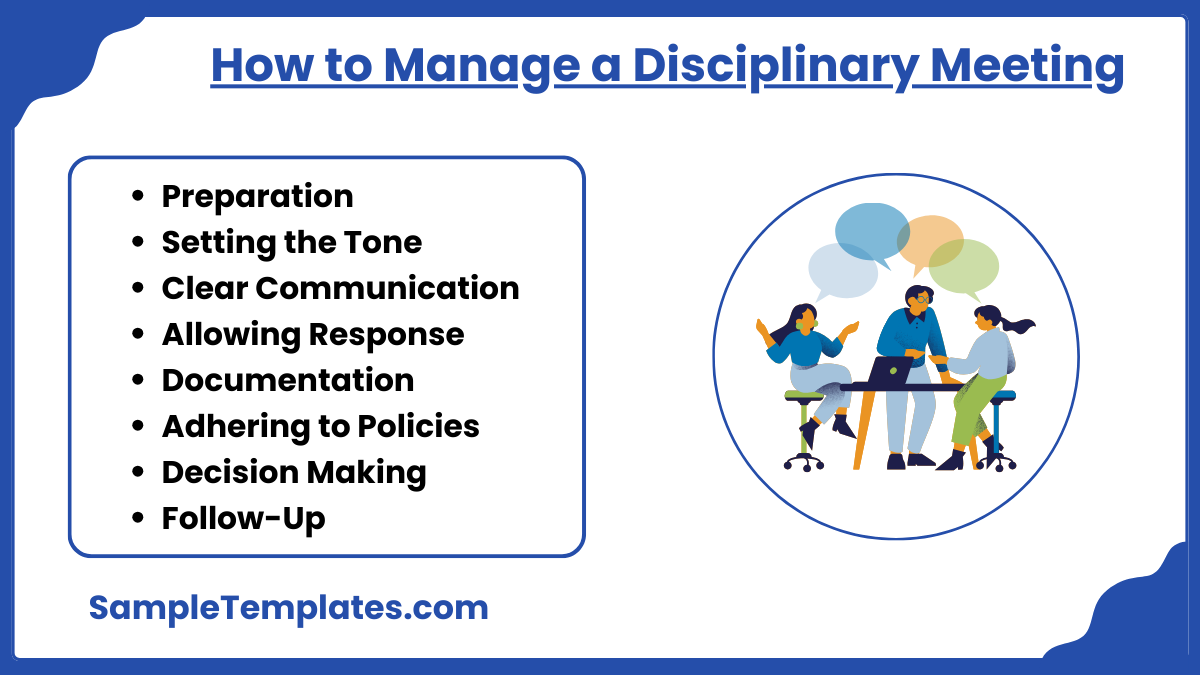
- Preparation:
- Thoroughly review all relevant documents, incident reports, and company policies beforehand.
- Prepare an agenda outlining the meeting’s structure and objectives.
- Ensure that all necessary parties, including HR representatives and any union officials, are informed and invited to attend.
- Setting the Tone:
- Start the meeting by clearly stating its purpose and emphasizing the importance of maintaining professionalism and confidentiality throughout the process.
- Establish a calm and neutral tone, avoiding any bias or pre-judgments.
- Clear Communication:
- Clearly explain the alleged issues and the reasons for the disciplinary action being considered.
- Reference specific examples and evidence related to the misconduct to avoid ambiguity.
- Allowing Response:
- Give the employee a fair opportunity to tell their side of the story without interruption.
- Listen actively and encourage them to provide their perspective, clarification, or any additional evidence they might have.
- Documentation:
- Take detailed notes or ensure that a designated note-taker does so to capture the discussion accurately, including statements and any decisions made.
- This documentation will be crucial for future reference, especially if the outcome is disputed or if further action is required.
- Adhering to Policies:
- Ensure that all discussions and disciplinary actions align with organizational policies and legal requirements.
- Refer to the employee handbook or specific policy documents during the meeting to clarify standards and procedures.
- Decision Making:
- After hearing all sides and reviewing the evidence, discuss the appropriate steps within the guidelines of your company’s disciplinary framework.
- Make decisions based on facts and consistent with how similar incidents have been handled to ensure fairness and avoid legal repercussions.
- Follow-Up:
- Clearly outline the next steps, including any disciplinary actions to be taken, timelines for review, and any potential consequences if the behavior does not improve.
- Schedule follow-up meetings if necessary to review progress or further discuss ongoing concerns.
6. Minutes Of Meeting For Discipline Committee
7. Disciplinary Hearing Minutes Sample
What are the 5 Disciplinary Procedures?
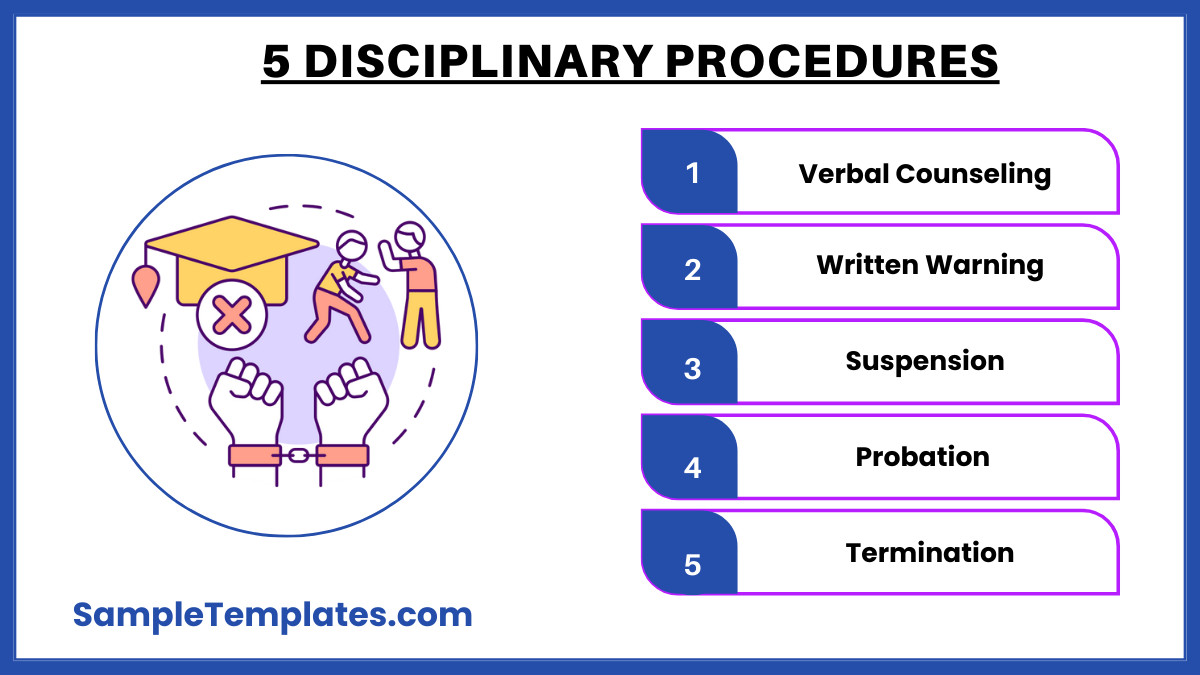
Disciplinary procedures are policies and processes organizations implement to address employee misconduct or performance issues. While specific procedures may vary, common disciplinary actions typically include:
- Verbal Counseling: Informal discussions between a manager and an employee to address minor issues. This involves providing feedback, clarifying expectations, and offering guidance on improvement.
- Written Warning: Issuing a formal written warning when the employee’s behavior or performance does not improve after verbal counseling. The document outlines the problem, expectations, and consequences if improvement is not achieved.
- Suspension: Temporary removal of the employee from the workplace as a more severe consequence for serious or repeated misconduct. Suspension may be with or without pay, depending on the severity of the situation.
- Probation: Placing an employee on probationary status, during which their performance is closely monitored. This may include specific improvement targets or conditions for continued employment.
- Termination: The final step, termination, occurs if the employee fails to meet expectations despite previous disciplinary actions. Termination may be immediate or follow a series of warnings, depending on the severity of the issue.
It’s important to note that these procedures should be outlined clearly in the organization’s policies and communicated to employees. The goal of disciplinary procedures is not only to address issues but also to help employees understand expectations, improve performance, and maintain a positive work environment. The severity of the disciplinary action should be proportionate to the seriousness and recurrence of the employee’s behavior or performance problems.
8. Disciplinary Committee Meeting Minutes Sample
What are the 4 Disciplinary Actions?
Disciplinary actions are measures taken by employers to address employee misconduct or performance issues. The specific actions may vary depending on company policies and the severity of the situation. Here are four common disciplinary actions:
- Verbal Warning: A verbal warning is an informal conversation between a supervisor or manager and an employee to address minor issues. It serves as an initial alert to the employee that their behavior or performance is not meeting expectations.
- Written Warning: A written warning is a more formal disciplinary action that involves documenting the performance or behavioral issues. The written warning is typically issued if the problems persist after a verbal warning. It outlines the specific concerns, expectations for improvement, and potential consequences if improvement is not achieved.
- Suspension: Suspension involves temporarily removing an employee from the workplace as a disciplinary measure. It may be with or without pay, depending on company policies and the severity of the misconduct. Suspension is often used for more serious offenses and provides time for both the employer and the employee to assess the situation.
- Termination: Termination is the most severe disciplinary action, involving the permanent separation of the employee from the company. It is typically considered when other disciplinary measures have failed to address the issues, and the employee’s conduct or performance is deemed unacceptable.
It’s crucial for employers to follow fair and consistent disciplinary procedures, ensuring that employees are aware of expectations, consequences, and the opportunity for improvement. Additionally, adherence to legal and ethical guidelines is essential to avoid potential legal repercussions.
9. Disciplinary Service Meeting Minutes
10. Disciplinary Hearing Disciplinary Meeting Template
11. Minutes Of Disciplinary Committee Meeting
What Is the Minutes of a Disciplinary Meeting?
The disciplinary meeting minutes offer prompts to include all essential material and serve as documentation that you have covered all of the topics that should be discussed during the hearing. The management meeting minutes contain all of the important information that you’ll need to keep track of during each disciplinary action plan . Furthermore, its goal is to guarantee that the disciplinary hearing is thorough, fair, and transparent. This is because the fairness of any disciplinary process will be a major element in determining whether or not any eventual disciplinary dismissal is appropriate.
FAQs
1. What should a disciplinary hearing entail?
Your boss will explain why the meeting is being held and go over the evidence they have. They should let you to present your case and respond to the allegations leveled against you. You should have the opportunity to ask questions, present your case, and summon witnesses.
2. What are the three steps in the disciplinary process?
In short, the statutory procedure entails three steps: a written description of the employee’s alleged wrongdoing and what the employer intends to do. A meeting to discuss the matter and make a decision, with the option to appeal.
3. Who is invited to a disciplinary hearing?
You have the right to bring someone to a disciplinary hearing with you, but you must notify your employer first. It can be a colleague or a representative of a labor union.
4. How do you write minutes of disciplinary hearing?
Document disciplinary hearing minutes by recording attendees, summarizing discussions, noting evidence presented, documenting decisions and actions taken, and ensuring accuracy and impartiality in a formal, objective tone.
5. What are the disciplinary procedures?
Disciplinary procedures manual typically involve investigation plan, notification, a disciplinary meeting, decision-making, and an appeals checklist. They aim to address misconduct or performance issues in a fair and consistent manner.
In conclusion, meeting minutes that are clear and effective ensure that everyone on your team is on the same page when it comes to outcomes and next steps. You’ll be well on your way to making all those meetings count with these strategies and templates. To help you get started with this, download our easily customizable and printable samples of Disciplinary Meeting Minutes today!
Related Posts
FREE 10+ Company Meeting Minutes Samples in MS Word | Google Docs | Apple Pages | PDF
FREE 10+ Board Meeting Minutes Samples [ Non Profit, First, Software ]
FREE 10+ Risk Management Meeting Minutes Samples in PDF | DOC
FREE 10+ Office Meeting Minutes Samples in PDF | DOC
FREE 10+ Nurses Meeting Minutes Samples in PDF | DOC
FREE 10+ Marketing Meeting Minutes Samples in PDF | DOC
FREE 10+ Grievance Meeting Minutes Samples[ Hospital, Redressal, Committee ]
FREE 10+ Financial Meeting Minutes Samples [ Committee, Board, Council ]
FREE 10+ Pre-construction Meeting Minutes Samples in PDF | MS Word | Google Docs | Apple Pages
FREE 10+ Weekly Meeting Minutes Samples [ Sales, Staff, Safety ]
FREE 10+ Faculty Meeting Minutes Samples in PDF | DOC
FREE 10+ Event Meeting Minutes Samples in PDF | DOC
FREE 11+ Team Meeting Minutes Samples [ Leadership, Remote, Project ]
FREE 10+ Operations Meeting Minutes Samples in PDF | DOC
FREE 10+ Management Meeting Minutes Samples [ Senior, Risk, HR ]
